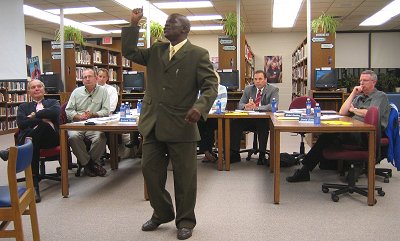- By Dan Veaner
- Around Town
 Print
Print  William Kabbis is the Head Teacher at the Mbaka Oromo school in Kenya, the equivalent of a 'Principal' in American schools. His school has been the recipient of donations and cultural exchange through Partnership of African and Lansing Schools (PALS), and he has spent the past two weeks visiting Lansing as a guest of PALS and the Ithaca Cayuga Rotary Club. Articulate and inspiring in his speech to the Lansing Board Of Education last week, Kabbis has also been visiting Lansing classrooms and talking to students, teachers, and administrators here.
William Kabbis is the Head Teacher at the Mbaka Oromo school in Kenya, the equivalent of a 'Principal' in American schools. His school has been the recipient of donations and cultural exchange through Partnership of African and Lansing Schools (PALS), and he has spent the past two weeks visiting Lansing as a guest of PALS and the Ithaca Cayuga Rotary Club. Articulate and inspiring in his speech to the Lansing Board Of Education last week, Kabbis has also been visiting Lansing classrooms and talking to students, teachers, and administrators here.He took an hour out of his busy itinerary to talk to the Lansing Star. This is the first of three installments of that interview. Kabbis was a bit formal by American standards, but open and expansive. He is grateful for the new classrooms, administration building and library that Lansing (and another group in Rochester) has provided and clearly determined to make the most of it. His school ranks number one in academic, athletic, and music achievement despite the many hardships his students (K through 8th grade) experience.
In this week's installment we talked about the contrasts between the Lansing schools and the Mbaka Oromo school. Next week we will cover his impressions of America and his observations of our classrooms. In the final installment we discuss his impressions of American stores, and advantages American children have.
Lansing Star: What differences strike you between the classes at your school and here?
William Kabbis: The difference that strikes me most is how equipped and organized these classes are. All the classes I have visited have got reading materials, teaching and learning aids, furniture on which the students are sitting, and where they are writing.
Books are in all the classes. Teacher's materials are readily available by contrast to Kenya. The classrooms have even got very expensive storage cupboards. They even have microscopes. In Kenya you can only see such things in a hospital.
I saw many facilities that are very conducive to learning compared to our school. When you go to my classrooms there are not enough desks for students to sit at. You find most students sitting down on the floor.
LS: At the school board meeting last week I was really moved when you told our school board that your class sizes are between 60 and 85 in a classroom. Do all of the new classrooms have desks now?
WK: No, no. They don't have desks. That is still a major problem in my school.
LS: How many of the classrooms do have desks?
WK: We decided that every classroom gets at least a few desks. We didn't want it to look like some classrooms have desks and other classrooms are totally empty. Those children could have felt subjected to torture. So we decided to balance every classroom with the few desks that are available. We wanted the whole school to look uniform, so it looks more like there is a shortage of facilities for the school than favoring one group over another.
LS: The students who get to class first get to sit at the desks?
WK: Yes. We made the system so that the children won't feel segregated or isolated. The faster you get to the classroom, especially when you are coming from the assembly, you will have a desk to sit at. The desks are used on a first come, first served basis.
A child who comes after other children who are already sitting at the desks will not blame any person for making him or her sit on the floor. They can only blame him or herself for having come to class after others. So you find that those sitting on the floor -- they readily accept it because they learn happily.
They also struggles just like these other children, because they know it's not a problem that someone has subjected them to the nature that has made them be that way.
LS: How many desks are in each classroom?
WK: Normally the children will sit comfortably if there are two to a desk, or three children per desk. The number of desks in a classroom is normally determined by the number of children in that class. We would wish each class to have 30 desks. If it had 30 desks that would sit 60 pupils. But children supersede 60 and go beyond even to 86 (in one classroom).
It is that number that will dictate the number of desks that we have in a class. Roughly a class would be comfortable with between 30 to 35 desks.
LS: But today how many desks are in each room?
WK: Today some classrooms have ten. There are classrooms with eight. There are some with nine.
LS: So a classroom with eight desks is between 16 and 24 children sitting at desks if the children are small enough... In other words most of the children are sitting on the floor.

William Kabbis at Lansing Board of Education meeting.
Academic achievement is #1 at the Mbaka Oromo school
WK: Yes. Most of them sit on the floor.
LS: These classrooms must be big to hold that many children.
WK: The standard size of classroom we normally build is 30' by 25'. A standard classroom should hold about 40 pupils. It's meant for 40, but the children that come are more than what a class should hold. I cannot turn them away because it is in my school that they also get solace, because we have very many orphans.
My school has an enrollment of 649 students. Out of that number 291 are orphans. Many of them choose my school because of my kindness. I am very kind to my children because I was also brought up in a poor family. I believe that as poor as your family might be, that hard work can pay.
So I admit them. I give them myself and my history as an example. So I am a role model for my students.
LS: How many classrooms are there now? Is there just one for each grade?
WK: Yes, we have just one for each grade. In the kindergarten we have a baby class. We have children from the age of three and four, and five. That's where they sit for a test that promotes them to grade 1. What you call 'grades' in America, we call 'classes' in Kenya.
LS: If you could have more classrooms would you be able to attract more teachers? In other words, two classrooms for grade one, two for grade two, and so on?
WK: It would happen. In Kenya those (kindergarten) teachers are not employed by the government. It is left for the community to employ them. If you come from a poor community there are no financial resources. It means that teachers volunteer their services. It becomes difficult for these teachers to volunteer because they are also parents whose children would lack food by the end of the day. So everything is a struggle.
But at least in my school I have teachers who volunteer their services to teach kindergarten.
LS: Does Kenya only employ first grade teachers and up?
WK: They only employ first grade up to grade eight. The government pays them.
LS: So would the government be willing to pay two first grade teachers if you had two classrooms for them?
WK: Yes, they would pay them.
The teaching staff in the whole country is minimal. The country is understaffed by teachers in schools. There are many teachers who are trained, but have not yet been employed because the government does not have money to pay their salaries.
LS: So if you did have the extra space for teachers you might not be able to get them right away?
WK: If I had extra space for teachers -- normally when the government looks at the number of pupils and the amount of space a school has. So they see at a glance that this school lacks certain teachers.
LS: So you are currently below the number of teachers the government would give you.
WK: That's right. Right now instead of having 17 teachers, we have nine.
LS: These numbers really strike me, because if class sizes in Lansing reach 19 our school board they talk about whether or not to hire a new teacher. They are seeing some budget crunches now, but even still -- 20 or 21 is much less than 60 or 80 students in a classroom. I want to ask if this makes it harder to teach students, but I am also thinking about what you told the school board about your school being number one academically, and in music and athletics.
WK: Now we are forced to sacrifice most of our time to give students more. The government sets the time to be in school from 8am to 4pm. I have set our time to be in school to be from 7am to 6pm. So that puts us ahead of the government's time (requirement) and ahead of other schools that feel they cannot sacrifice.
So it is through sacrificing that we make a difference in student performance. We also go to school from Monday through Saturday, while the government's time is Monday through Friday. We do that so that we can try to cover what 17 teachers would have covered. Because we are nine we make more of a sacrifice so that we cover those topics.
LS: That's a difference between our schools, too. Our teachers here are unionized. The union sets the hours they work each day.
WK: I have a union, but when it comes to work there is liberalization. Each school can create its system of work so long as you are working within the education acts and bylaws for the benefit of the children. Some people ask me, "If you are working from Monday to Friday, why are you extending up to Saturday?"
I'll say, 'I'm extending to Saturday so I will get a chance to cover what I would have not covered if I have to limit myself to Friday.' So that's how we work.
----
v4i41



